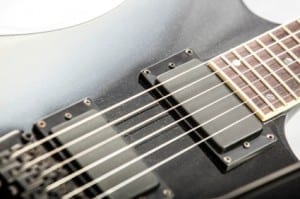If you've checked out part one of our series on guitar pickups and their uses in the studio, you got an overview of the basic types of pickups and what they can do for you guitar tracks.
However, though there are two primary types of electric guitar pickups that are commonly used (single coil and humbuckers), there are tons of different variations among those pickups, and guitarists spend years (ok, lifetimes) shuffling through them all, coupled with different guitars, trying to find their own personal tone – the tone that defines them.

But there are tons of types of pickups out there. A quick internet search reveals pickups that MSRP at $40 and others that MSRP for $400. Boutique models can be much more expensive even than this. Pickups are a big difference (but certainly not the only difference) in a Squier Strat that costs a couple hundred bucks and an American-made Fender version that costs a couple thousand.
And we want to use part two of the guitar pickups article to look at what really differentiates the sound in different pickups, and what to look for if you are looking for a particular sound.
To recap from the first article, almost all popular electric guitars use magnetic pickups that consist of a length of wire wrapped around a bobbin or two (the former is a single coil, the latter is a humbucker). The more times a wire is wrapped, the louder (or “hotter”) the pickup is. However, winding the wire more also causes the pickups to lose high-frequency response.
Since wire in humbuckers must be wrapped around two bobbins, there are inherently more turns. This is why humbucker pickups are louder than their single coil counterparts, and also why they are warmer, with less high frequency response.
This is also why P-90s are such popular single coil models. They are warmer than most classic single coil pickups because they are larger and more complex, therefore requiring more turns of wire.
Single coil pickups are fairly easily susceptible to magnetic interference, which is one of the reason humbuckers were designed in the first place (the two bobbins of the humbuckers are placed with their polar ends at the opposite to eliminate the noise). But since guitarists still love the bright sound of single coils, companies in recent decades sought to make noiseless single coil models.
These were done in a couple of ways, usually by adding a metal barrier around the pickups to eliminate interference, or by using what is actually a humbucker configuration, but by stacking the two single coils on top of each other rather than placing them side-by-side.
However, regardless of setup, these still tend to take a little away from the classic single coil sound, which is why traditional single coil pickups have managed to still be widely used.
There are two types of humbuckers you will see: covered and uncovered. Covered models come with a rectangular metal plate while uncovered models do not. The latter looks exactly like what these pickups are: two single coil pickups wired together.
There’s no difference in the wiring, just the fact that there is a cover or not. The preference is up to you. Some have noted that because of resonance, covers can cause feedback problems when used at high volumes, and some uncovered humbuckers have been noted as “brighter.” Whether the latter fact is desired is certainly up to the individual player.
These are not anywhere near all the pickup options you have, but are some good specifics to give you more of an idea how they work and what will give you different sounds in your home studio.